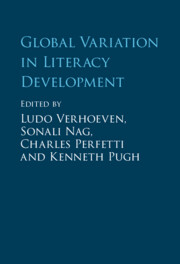Book contents
- Global Variation in Literacy Development
- Global Variation in Literacy Development
- Copyright page
- Contents
- Figures
- Tables
- Contributors
- Abbreviations
- 1 Introduction
- Part I Regional Variations
- Part II Neurobiological and Ecological Markers
- 11 Writing Systems and Global Literacy Development
- 12 Brain Foundations for Learning to Read
- 13 Genetics and Literacy Development
- 14 Role of Self-Regulation in the Transition to School
- 15 Socioeconomic Status, Sociocultural Factors, and Literacy Development
- 16 Sensitivity to Contextual Factors in Literacy Interventions in the Global South
- 17 How Teachers Contribute to Children’s Literacy Success
- 18 The Literacy Ecology of the Home
- 19 Parental Literacy Support in Monolingual and Bilingual Contexts
- 20 Global Literacy
- Index
- References
15 - Socioeconomic Status, Sociocultural Factors, and Literacy Development
from Part II - Neurobiological and Ecological Markers
Published online by Cambridge University Press: 23 November 2023
- Global Variation in Literacy Development
- Global Variation in Literacy Development
- Copyright page
- Contents
- Figures
- Tables
- Contributors
- Abbreviations
- 1 Introduction
- Part I Regional Variations
- Part II Neurobiological and Ecological Markers
- 11 Writing Systems and Global Literacy Development
- 12 Brain Foundations for Learning to Read
- 13 Genetics and Literacy Development
- 14 Role of Self-Regulation in the Transition to School
- 15 Socioeconomic Status, Sociocultural Factors, and Literacy Development
- 16 Sensitivity to Contextual Factors in Literacy Interventions in the Global South
- 17 How Teachers Contribute to Children’s Literacy Success
- 18 The Literacy Ecology of the Home
- 19 Parental Literacy Support in Monolingual and Bilingual Contexts
- 20 Global Literacy
- Index
- References
Summary
This chapter reviews examples of socioeconomic and sociocultural factors, the influence they exert on literacy development, and explanatory mechanisms for these influences. Research on variables with a broad geographic base is reviewed under the themes of socioeconomic status, literacy teaching practices at home, and the dynamics between the home and school language. The level of family income, household wealth, and parental education capture socioeconomic status and are often indicators of children’s access to literacy resources. Activities at home capture formal and informal teaching moments which may nurture literacy learning. Family choices about the language of instruction and teacher attitudes are examples of the intangible links between home and school language. These factors are potentially as important in explaining individual differences in children’s literacy attainments as within-child factors such as vocabulary knowledge. The associations of socioeconomic and sociocultural factors with emergent literacy, component skills of literacy, and grade-level achievement tests are also examined, framing the discussion around findings that are more consistent across contexts. It is concluded that educational practice that is sensitive to socioeconomic and sociocultural disadvantage needs to prioritize access to resources and instruction that consolidates skills and reduces fragmented development in literacy skills.
Keywords
- Type
- Chapter
- Information
- Global Variation in Literacy Development , pp. 333 - 352Publisher: Cambridge University PressPrint publication year: 2023

